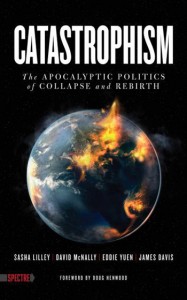 A review of Catastrophism: The Apocalyptic Politics of Collapse and Rebirth, by Sasha Lilley, David McNally, Eddie Yuen and James Davis (Oakland: PM Press, 2012, 178 pp.). Also available at Toward Freedom and ZNet:
A review of Catastrophism: The Apocalyptic Politics of Collapse and Rebirth, by Sasha Lilley, David McNally, Eddie Yuen and James Davis (Oakland: PM Press, 2012, 178 pp.). Also available at Toward Freedom and ZNet:
The year 2012 didn’t bring us the end of the world, nor the end of capitalism and Coca-Cola that Evo Morales promised last summer. It still remains to be seen whether or not it will have ushered in the resurgence of indigenous resistance that was proclaimed by the more than 40,000 Zapatistas who marched in Chiapas last December 21st. But whatever new political developments the coming years may or may not bring upon us, it’s clear that we haven’t seen the end of the apocalyptic outlook that 2012 came to represent.
Popular culture, of course, has been reveling in apocalypse and catastrophe for a long time. From serious literature to pulp fiction, from punk and alt-rock music to teen novels, from the art house to the multiplex – not to mention the ultra-violent world of video games – American culture has been saturated with images of apocalypse since long before 2012. With the catastrophic weather predictions of scientists’ climate models coming to fruition with devastating accuracy, decades earlier than anticipated, we’re not likely to see the end of apocalyptic thinking for some time.
What does this mean for social movements, and for those of us who seek a more just human order in the midst of climate breakdown and persistent financial uncertainty? Can the specter of apocalypse serve to invigorate popular movements, or is it merely an outlet for escapism and despair? What of the significant ranks of radical environmentalists who now believe that a restoration of biodiversity can only follow the collapse of civilization? Are such views part of the solution or part of the problem?
A new book, Catastrophism: The Apocalyptic Politics of Collapse and Rebirth, by four activist-scholars associated with the Berkeley-based Retort Collective is an essential contribution to this profoundly important discussion. Each of the authors in turn offers their distinct perspective, scholarship and insights to the analysis of “catastrophism” among environmentalists, in movements of the left and the right, and in popular culture itself. Overall, the contributors make a compelling case for the view that apocalyptic thinking is a dead-end for the left, a chronic enabler for the right, and an outlook that radical movements embrace at their peril.
A foreword by Doug Henwood introduces the volume on an inviting though frequently sarcastic note, asserting from the outset that catastrophic thinking is fundamentally paralyzing for popular movements. He quotes Engels’ biting critique of Malthus’ still-popular forecasts of doom as “the crudest, most barbarous theory that ever existed, a system of despair,” arguing instead that “recovering a utopian sensibility is about the most practical thing we could do right now.” This is a theme I’ve explored in my recent book on climate justice, and one that has been significantly elaborated by a new generation of utopian scholars; it is unfortunate that none of the main contributors to this book chose to elaborate any further on this point.
However, we are offered a panoramic and often illuminating review of the uses and abuses of catastrophe in various spheres of thought. Sasha Lilley’s introduction brings up two of the volume’s persistent themes: that “[t]he politics of fear… play to the strengths of the right, not the left,” and that catastrophic thinking consistently fails to realize its promises of a “shortcut” to a better world. Popular commentators like Chris Hedges and Naomi Wolf, who tend to see fascism lurking around every corner, tend to lose sight of the ways in which the “politics of fear” lead to “panic and powerlessness,” ultimately serving the agendas of the extreme right.
Eddie Yuen, editor of two essential volumes that analyzed the emergence of anticapitalist movements in conjunction with the Seattle WTO protests, focuses his chapter on the prevalence of apocalyptic thinking in the environmental movement. While there is no question that we are in a “genuinely catastrophic moment” in human history, the litanies of calamity often emphasized by environmentalists have led to a “catastrophe fatigue” that ultimately pacifies rather than energizes most people. Yuen invokes the familiar figures of Thomas Malthus and Al Gore to bookend his analysis of how catastrophic predictions often fail to usher in positive social outcomes. (Gore, it is rarely acknowledged, was among the first to predict that an inadequate response to climate change would likely lead to increased political repression.) Further, false predictions of catastrophe, from the “population bomb” to the “Y2K” frenzy – fueled in part by Helen Caldicott and many environmentalists – often serve to discredit environmental predictions in the eyes of much of the public.
Apocalyptic scenarios, in Yuen’s words, serve as “a kind of ‘substitutionism,’ in which a miraculous event … transforms consciousness, wipes the slate clean and abruptly changes the world [without] the need for difficult organizing and conflictive politics.” For Yuen, today’s popular forecasters of ecological collapse are more likely to fuel right wing fanaticism, e.g. calls to seal the borders to immigrants, than to facilitate a progressive awakening. Real solutions “must be prefigurative and practical as well as visionary and participatory,” appealing to “community and solidarity” rather than “austerity and discipline,” but unfortunately the book offers few suggestions for how to actualize this. Radical disaster relief efforts, from Common Ground in New Orleans to Occupy Sandy, offer one inspiring model of how to help further utopian expectations in apocalyptic times, and the analysis here could have been strengthened by a discussion of such examples, among others.
The book’s two in-depth historical chapters are more expansive in their scope, and are generally the most satisfying. Author and Against the Grain radio host Sasha Lilley offers a rather thorough critical analysis of catastrophic trends on the left, from the mid-nineteenth century to the present. Her approach draws on a distinction once raised by Lukács between a “deterministic” view that ever-deepening crises of capitalism are historically inevitable, and a “voluntarist” outlook, emphasizing the revolutionary potential of popular responses to worsening economic conditions. Of course these two approaches are often linked like hand and glove. While Marx emphasized the primacy of class struggle, his collaborators and successors were more inclined to invoke the inevitability of crisis and capitalism’s “certainty of doom.” In the early 20th century, Rosa Luxemburg believed capitalism would “collapse against absolute limits,” and the Stalinist left often saw world revolution as imminent, but thinkers such as Gramsci and the council communist Anton Pannekoek offered a more measured view, anticipating the ways in which crisis often serves to strengthen the capitalist system. Lilley is rather dismissive of both Wallerstein’s World System Theory and Baran and Sweezy’s often prescient analyses of the system’s current tendencies toward stagnation, but generally locates these views within a clear and engaging historical perspective.
The origins of the “voluntarist” approach emerge somewhat earlier, with roots in mid-nineteenth century Russian nihilism, among other outlooks. In the US, the strongest arguments for a “worse the better” view are often rooted in the dramatic labor upsurge of the 1930, but Lilley argues convincingly that the Depression Era labor movement was the exception that proves the rule. More typically, Lilley argues, labor militancy has risen during periods of economic expansion and rising expectations, a trend that also significantly shaped the movements of the 1960s. When leftists have “hailed fascism and dictatorship” as harbingers of an impending revolt, they have usually been severely disappointed, from the Italian and German communists of the 1920s and ’30s to the Weathermen and the Red Army Faction of the late sixties and 1970s.
From Estonia in the 1920s to Ché’s Bolivia in the sixties, beliefs that revolution would inevitably emerge from “objective conditions” and severe state repression have led revolutionaries toward disaster more often than triumph. But this hasn’t prevented ambitious revolutionaries from reveling in elevated expectations. Lilley reports that both Mao in China and an obscure Argentine Trotskyist named Posadas declared that socialism would inevitably emerge from a nuclear war. While the right more commonly “thrives on fear,” she correctly emphasizes that “[r]adical mass movements typically grow because they offer hope for positive change.”
Equally expansive in its historical scope is the Irish writer and filmmaker James Davis’ chapter on the catastrophism of the right. Apocalyptic visions, Davis argues, are “central to the propaganda and ideology of the modern right,” and he offers a wealth of evidence to bring that point home. As with the dual outlooks shaping left catastrophism, the right’s version also assumes two interrelated forms. “Disease catastrophism” is rooted in scenarios of impending societal collapse, from Spengler’s “twilight of the West” to Huntington’s “clash of civilizations,” while “cure catastrophism” is expressed most fully in a variety of revenge scenarios from the fantasy of a redemptive race war to the Christian millenarian idea of the rapture. Davis argues that both are rooted firmly in the “narrative model of religious apocalypse.” (Unfortunately, these two poles of right catastrophism are not defined unambiguously until close to the end of the chapter.)
Davis recounts the origins of modern Christian evangelism from the early 19th century to the rise of Billy Graham in the 1950s and the movement’s increasing politicization in reaction to the expansive social progress of the New Deal and the 1960s. While this story has been told elsewhere in much more detail, Davis’ account underscores the ideological roots of various trends on the right. For example, right wing catastrophism has long been steeped in conspiracy theory, with 1970s rightists attacking the Frankfurt School for originating “cultural Marxism” (a view apparently borrowed from the publications of former leftist Lyndon LaRouche), and of course today’s scapegoating of post-sixties intellectuals such as Frances Fox Piven. For the right, Western civilization is always on the decline, whether the primary cause is “permissive egalitarianism,” the “evil empire,” (both terms are rooted in the writings of Leo Strauss), or today’s Islamic extremism. Europe’s Muslim populations have been targeted by numerous xenophobic right wing movements in recent years, and Davis dissects the origins of ideas that were expressed most disturbingly in the manifesto of the mass murderer Anders Breivik, issued just prior to his lethal attack on a social democratic youth camp in Norway in 2010.
While the right often adopts a veneer of anti-statism, it invariably extolls the state’s military and police powers. Even while condemning the state as a “vehicle of liberal progress,” rightists tend to celebrate the “harsh and previously off-limits policies” that result from casting immigration and crime as catastrophic problems. The politics of fear spread by right catastrophists serves to “disorient the left” and often put it on the defensive. “Fear,” Davis argues,” is the bedfellow of right wing catastrophism and it is expertly manipulated by the state.” Examples abound, from the origins of the Cold War, to the (Cheney, Rumsfeld, et al.) Project for a New American Century’s predictions of a “new Pearl Harbor,” and even some of the rhetoric that accompanied the 2008 bailout of major US banks. Davis’ view that “[c]atastrophism for the right is the fight against equality and for war, hierarchy and state violence,” is supported by a wealth of evidence, both historical and contemporary, in theory as well as in practice.
Following these two wide-ranging historical examinations, York University political scientist David McNally offers some fascinating glimpses of the ways that visions of apocalypse are depicted in popular culture. How can we best comprehend the pervasive images of zombies and vampires in pop culture today, and what different forms has this taken in other parts of the world? The most fully developed discussion here is of the varied images and meanings associated with the Frankenstein story, from its early nineteenth century origins until today. According to McNally, Mary Shelley’s London was literally immersed in a “corpse economy,” where markets in human body parts were central to the rise in medical knowledge and education, even as the brutal rhythms of early industrial labor proliferated images of the “living dead.” When Hollywood adopted the tale, however, Frankenstein’s monster was deprived of the articulate self-consciousness that was so central to Shelley’s narrative, foreshadowing the increasingly zombified image of workers under late capitalism.
McNally explains the rise of the zombie myths that accompanied the globalization of West African slavery and its fullest elaboration in the cane fields of Haiti. Zombies started out as slaves, but soon became a metaphor for the “dispossession of the self” through wage labor. In Hollywood during the 1960s and seventies, zombies became flesh-eaters, and thus an even more extreme metaphor for manic consumerism. Interestingly, zombies and witches have become significant cultural images in modern-day Africa, where the ravages of the global economy have devastated communities, and spread unprecedented ravages of disease and displacement. Apparently, images of zombie revolt have also taken hold in contemporary Africa, but McNally offers no further details on this, instead transitioning to a lengthy description of a film by Wes Craven, whose allegorical images of inner city zombies come across as a little too obvious. McNally concludes by urging that we read present-day catastrophes dialectically, to examine their underlying truth while eschewing simple invocations of apocalypse. This chapter could have been more satisfying, I’d suggest, if he’d more fully followed that advice.
In some ways that can also be said about the book as a whole. As a work of historical analysis, its scope is impressive and often enlightening. The authors persist in pressing readers to avoid simplistic conclusions and the superficial appeal of apocalyptic images, a compelling and important message for today’s movements. But except for several broad invocations of the imperative of mass organizing, they don’t offer many contrasting images of a better way forward. This is a significant oversight if we acknowledge that current trends toward increasing environmental and financial chaos are both likely to continue. If we accept the warnings of climate scientists, the devastating droughts, floods and wildfires of recent years are only the first stirrings of an increasingly unstable climate regime, which will have genuinely catastrophic effects on communities throughout the world.
This may be news to many in the US, but in much of the global South people have been living with this altered reality for several years now. Even if greenhouse gas emissions are sharply curtailed this decade – a scenario all but precluded by recent non-developments in the UN-sponsored international climate negotiations – the persistence of carbon dioxide in the atmosphere means that everyone will be living with the consequences of increasing climate chaos for our entire lifetimes. It’s clear that a more dialectically nuanced understanding of catastrophe and the underlying potential for positive transformation is needed if we are to avoid a collapse into total despair. The transformative potential of apocalyptic scenarios has often been central to utopian thinking, from the radical millenarian movements of the Middle Ages to the 20th century revival of the utopian tradition in the writings of H.G. Wells and others. While the authors of Catastrophism offer an essential antidote to a superficial politics of apocalypse and redemption, it will be up to others, especially the emerging generation of activists and theorists, to articulate an outlook that can inspire the profound social transformations that today’s environmental and financial crisis render more necessary than ever.
Brian Tokar is a lecturer in Environmental Studies at the University of Vermont, director of the Institute for Social Ecology (social-ecology.org), author, most recently, of Toward Climate Justice: Perspectives on the Climate Crisis and Social Change (New Compass Press, 2010), and co-editor (with Fred Magdoff) of Agriculture and Food in Crisis: Conflict, Resistance, and Renewal (Monthly Review Press, 2010).


